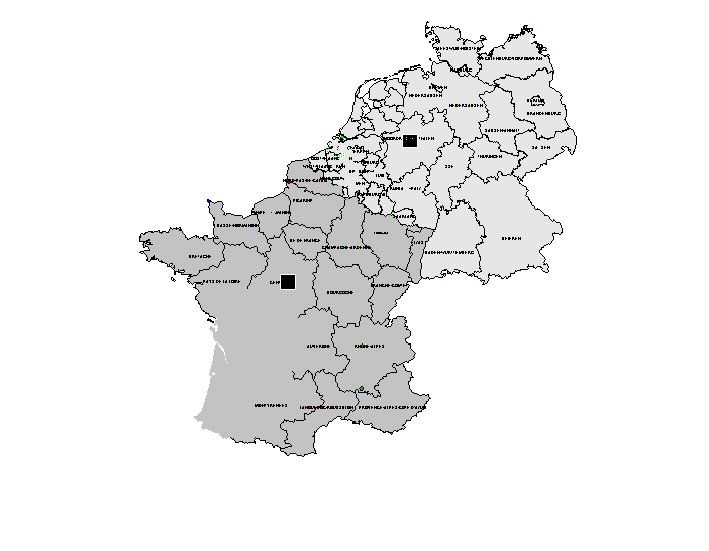A. Groothedde
The design of a network for a logistic service provider.
Masters thesis,
Report 99.3.LT.5052, Transport Technology, Logistic Engineering.
The increasing competition and the removal of the national borders in
Europe, force producers in Europe to gain cost savings in their business
process. Often, companies try to lower the costs by concentrating on their
core businesses. Since producers of products in general do not consider
the logistical sub-processes as their core business, these sub-processes
are frequently contracted out. This trend will only become stronger in the
future.
These developments create changes for logistic service providers
in Europe. A logistic service provider is a company that offers logistic
services to other companies. The increasing interest of companies in
outsourcing their logistic activities, leads also to increasing attention
to the activities of a logistic service provider.
This thesis considers the basic activity of a logistic service provider:
shipping goods. More precisely: the means that a logistic service provider
uses to offer his services are examined. The means that we refer to is the
network, comprising the depots, the hubs and the transport links between
them. The goal of this thesis is to develop a design process for such a
network. Figure 1 presents an example of a network with two hubs. The
service area comprises The Netherlands, Germany, France and Belgium.

Figure 1. An example of a network configuration
The ambition to develop a design process requires more insight in the
business process of a logistic service provider. Looking closer at the
activities, nine sub-processes can be distinguished:
- Collection of the incoming goods flow in the depot;
- Transfer at the depot of the collected goods to the trucks that
transport the goods to the hub;
- Transportation from the depot to his hub;
- Sorting of these shipments to their destined hub;
- Network transportation from the sending to the receiving hub;
- Sorting of the incoming goods flow to their final destinations;
- Transportation from the hub to the assigned depot;
- Transfer at the depot of the sorted incoming goods from the hub to the
distribution tours;
- Distribution of the shipments in the region of a depot.
It is clear that several sub-processes are closely interrelated: 1 and 9,
2 and 8, 3 and 7,4 and 6 are the same processes but in the reversed order.
These sub-processes are discussed subsequently and the accompanying cost
structures are determined.
In the design of the network three decisions can be distinguished:
Develop a model that determines:
- the optimal number of hubs;
- the optimal location of those hubs;
- the optimal assignment of the depots to the hubs.
The three decisions are known as the hub location problem (HLP) and are
treated simultaneously in on optimisation heuristic that will be discussed.
Another decision, which is not extensively treated in this thesis, is the
determination of the optimal set of regions. This is not included in the
optimisation heuristic but an approach to take the effects of merging
regions afterwards is discussed.
In practice such an existing division of the service area into regions is
always available. In general the gathered information is aggregated to
these regions and one is forced to adopt this division of regions to
enable an appropriate analysis.
The heuristic that combines the three decisions optimises for a certain
objective function by adjusting the network configurations. For i=1..k the
heuristic subsequently places i hubs at the n predefined points of
concentrated supply and demand of shipments (depots in regions). The
remaining (n-i) depots are all assigned to one of the i hubs in a
cost optimal way. The configuration is adjusted by the heuristic again
in some skilful way until a prescribed limit is reached.
Since the HLP-problem is NP-hard, the odds are to end in a local optimum.
To avoid the pitfall of a local optimum the technique of tabu search is
applied. This means that earlier tried movements are excluded from further
examination (are declared tabu), thus avoiding falling back into local
optima. A property of a heuristic however, is that the achievement of a
global optimum is never guaranteed. Therefore the correctness and
performance of the heuristic has to be determined. Enumerating the
complete set of solutions to the problem and calculating the value of the
objective function can validate the heuristic. This approach is feasible
for smaller problems and is applied in this thesis.
The performance of the implemented heuristic for larger problems is determined
by comparing the results with publicised results in the literature.
At the end of this thesis the developed design process is applied to a
case. The possible situation of a European logistic service provider is
considered. Data about the traffic between 20 distinguished regions in The
Netherlands, Germany, France, Belgium and Luxembourg is collected.
Information about costs and times are extracted from projects of the
constancy of Districon. The execution of the design process results in a
proposed cost- and lead time-efficient network configuration. The
properties of the network are discussed and also a sensitivity analysis is
executed to determine the influence of variations in the used data.
The discussed theory and the application in this thesis show that the
model is appropriate to optimise a network configuration for both costs
and lead-time performance. The drawback of the model is the inflexibility
to evaluate networks with a (slightly) different structure.
Reports on Logistic Engineering (in Dutch)
Modified: 2000.03.21;
logistics@3mE.tudelft.nl
, TU Delft
/ 3mE
/ TT
/ LT.

